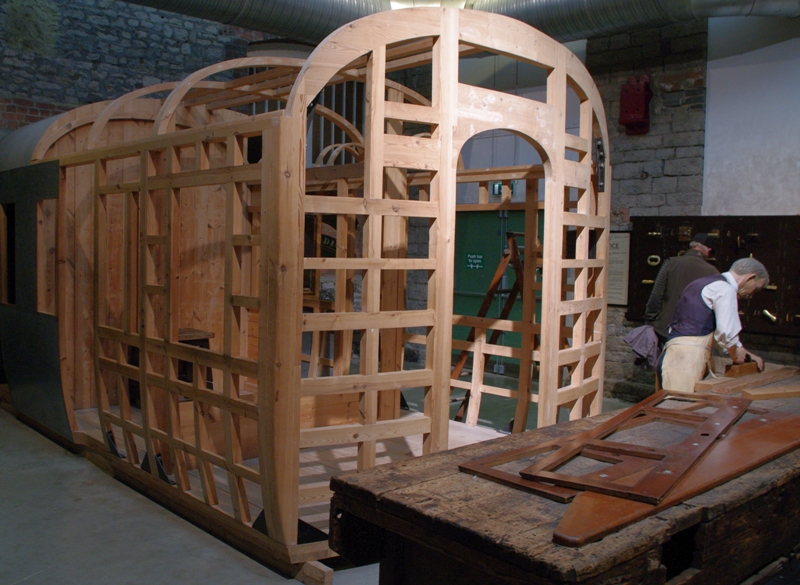| George Jackson Churchward became Locomotive, Carriage and Wagon Superintendent after Dean retired in 1902. Coaches to Dean's design continued to be ordered until the beginning
of 1904; although there were a couple of experimental designs during these 2 years. The first of Churchward's own designs did not appear until late 1904 and were a huge design leap from
Dean's clerestories. The Dreadnoughts, named after
the massive battleships that appeared 2 years later, were just that. Enormous. In fact they were the biggest every coach to appear on the railways of mainland Britian. Whilst
19" shorter than the BR Mk 3 coach (75' 6) that was introduced in 1975, they were 6" wider at 9'6"; making the cross sectional area of a Dreadnought 702 sq.ft vs 680 sq.ft for the
Mk 3. Something that was only possible due to the wide loading gauge inherited from broad gauge days.
A feature of all of Churchward's coaches was the toplight. Above every window, corridor and compartment, was a 7" tall fixed pane. The height matching the height of the louvred ventillators in the doors. The width of the pane varied from 11¾" above the compartments windows to 2' 3⅜" above the corridor windows. There were usually 2 panes above the large corridor windows, EXCEPT above some of the end corridor windows which only had one. It is said that the Dreadnoughts were unpopular with the public, who wanted a door at every compartment and thus followed the Concertina coaches in 1906. Concertina coaches were 9' wide and were thus able to traverse the GWR lines that had not been built to the broad gauge. To keep the door handles within the 9' loading gauge the doors were flat which gave the coaches their distinctive appearance of a concertina. The Concertina coaches were followed with a more 'normal' design where the doors were the same profile as the carriage body. For the lack of any other distinguishing feature these coaches have become referred to as Toplights. The early Toplight coaches were wooden panelled, similar to the last Dean coaches, but with elliptical roofs and wider bodies. Toplight coaches are subdivided into three subclassifications: Bars 1, Bars 2 and Steel (sometimes wrongly called MultiBars). Bars 1 and Bars 2 had wooden panels, Steel had steel panels without beads over the joins, but were painted as if they had panels until the 1927 livery. | |
| The identifying feature of Bars 1 design is that at the end of the sides the eaves panel continues above the window level panels. On later Bars 2 coaches the there is no eaves panel above the window level panels; instead these panels continue up to the gutter. As coaches aged and panels started to be repaired with steel over-panels it can be difficult to distinguish between the two designs. | 
|
| As well as new body designs Churchward developed a new chassis and bogies. Over the years there were three separate designs of truss:
Bar Trusses. Adjustable queenposts and flat bars between the queenposts and diagonally to the solebars. The outside trusses were 2½" x 1" and the inside ones were 2" x 1". Inside bars were only required for 70' coaches. The truss bars were oriented horizontally between the queenposts. So that the truss bar could be attached to the back of the solebar it needed to be oriented vertically. The trusses of the Dreadnought and Concertina coaches had a twist midway along the length of the sloping trusses. Whereas behind the Toplight solebars there was a boss at the end of the truss rod that converted the orientation to vertical. The lower half of the queenposts was threaded and 2 large nuts provided the adjustment. Multibar Trusses. The queenposts were angle iron and had casting at the bottom. Through this casting passed the round truss rods. The sloping truss rods were bigger than the horizontal rods, of which there were 2. The horizontal rods had adjustment nuts on their ends. There were also transverse rods bewteen the bottom of the queenposts. Angle Truss. Both the queenposts and all the trusses were made of 3½" angle iron. The angle iron was inverted. There was no adjustment possible with this design. Instead the fabrication was such that the solebars curved up until the body was placed on the underframe when the weight of the body made the solebars straight. The underframe changes did not coinside with the changes in body design: | |
| Dreadnought | Concertina | Bars 1 | Bars 2 | Steel | ||
| Bars | Multi | Angle | ||||
